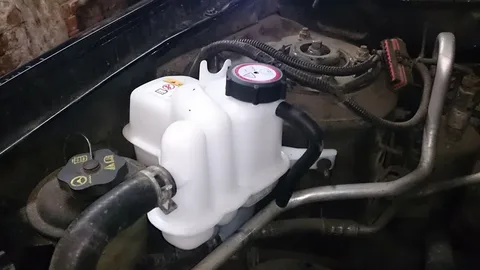Owning a car like the 2001 Ford Focus requires regular maintenance to ensure it runs smoothly. One key component to check is the coolant reservoir. If you suspect a leak, it’s essential to address it promptly to prevent engine overheating or further damage. This guide will take you through the steps to identify and manage a leaky 2001 Ford Focus Coolant Reservoir.
Understanding the Role of the Coolant Reservoir
The coolant reservoir plays a crucial role in your vehicle’s cooling system, functioning as a storage tank for excess coolant that expands as the engine heats up. Coolant, a mixture of water and antifreeze, absorbs heat from the engine and prevents it from overheating. As the engine operates and the temperature increases, the coolant expands and is stored in the reservoir to maintain the proper level in the cooling system. The coolant reservoir helps ensure that the engine temperature remains within an optimal range, preventing it from becoming too hot, which could lead to engine failure or permanent damage.
In the case of the 2001 Ford Focus, the coolant reservoir plays an essential role in maintaining the proper coolant levels. When the engine operates, the coolant expands and flows into the reservoir, and when the engine cools down, the coolant contracts and is pulled back into the system. The reservoir, therefore, helps balance the coolant level by storing the excess and providing a reserve supply. This system helps avoid coolant loss and ensures the engine has enough coolant to maintain its cooling efficiency.
A leak in the coolant reservoir can disrupt this carefully balanced system. If coolant is leaking from the reservoir, it can result in the loss of coolant, causing a drop in the system’s coolant levels. Without sufficient coolant, the engine will be unable to cool effectively, increasing the risk of overheating. Overheating can lead to serious engine issues, such as warped cylinder heads, blown gaskets, or even complete engine failure.
Gathering the Necessary Tools and Materials
Before beginning your inspection, make sure you have the following items:
– Clean cloth or kitchen roll
– Coolant (recommended for 2001 Ford Focus)
– Replacement coolant reservoir (if necessary)
– Safety goggles and gloves
These tools and materials will help make the inspection and repair process smoother and more efficient.
Locating the Coolant Reservoir in Your 2001 Ford Focus
Open the bonnet of your 2001 Ford Focus to access the engine bay. The coolant reservoir is usually found near the front or to the side, distinguished by its translucent plastic body and a cap labelled with a coolant symbol. Ensure the engine is excellent before inspecting the area to avoid burns. Use a torch to improve visibility, especially if the lighting is poor. Familiarising yourself with the exact location will streamline the inspection and any subsequent repairs.
Inspecting the 2000 Ford Focus Coolant Reservoir for Leaks
Begin by visually inspecting the 2000 Ford Focus Coolant Reservoir for any obvious signs of leaks, such as damp spots, coolant stains, or small cracks in the plastic. Pay close attention to the seams and the area around the cap. Use a clean cloth to wipe the reservoir and check if any liquid reappears.
Examine the hoses connected to the reservoir for any signs of wear, cracks, or loose clamps. If the engine has recently been running, look for steam or hissing noises, which could indicate a leak. Additionally, check the coolant level; a consistently low level may suggest a slow leak that needs addressing.
Addressing a Minor Leak vs. Replacing the Reservoir
If you find a minor leak or crack, consider using a suitable sealant for a temporary fix. Clean the affected area thoroughly before applying the sealant to ensure it adheres properly. However, it’s best to replace the coolant reservoir for more significant damage. Start by draining the existing coolant and disconnecting the hoses attached to the reservoir. Remove any mounting bolts, then carefully lift out the old reservoir. Position the new reservoir, secure it with the mounting bolts, and reconnect the hoses. Make sure all connections are tight to prevent future leaks.
Refilling and Bleeding the Coolant System
Once the reservoir is repaired or replaced, carefully refill it with the appropriate coolant for the 2001 Ford Focus. Use a funnel to avoid any spills. Start the engine and allow it to reach its operating temperature.
This process helps circulate the coolant through the system. If your model has a bleeder valve, open it to release any trapped air. Keep an eye on the coolant level, as it may drop once the air is expelled, and top it up as necessary. Monitor the temperature gauge to ensure the engine is not overheating during this process.
Ensuring Proper Maintenance to Prevent Future Leaks
Leaks in your vehicle—from the engine, transmission, or other components—can cause significant damage and lead to costly repairs. Regular maintenance is crucial in preventing future leaks and ensuring the longevity of your car. Here are five essential tips for keeping your vehicle leak-free:
Regularly Inspect Seals and Gaskets
Inspect all rubber seals and gaskets around doors, windows, the oil pan, valve covers, and transmission regularly. Over time, seals and gaskets can degrade, leading to leaks. Replace worn or cracked seals immediately to prevent fluid loss or water leaks.
Maintain the Cooling System
Check the radiator, hoses, and coolant reservoir for any signs of leaks or cracks. Ensure your cooling system is properly maintained by inspecting for leaks in hoses or radiator seams, which can cause coolant loss and lead to engine overheating. Replace any damaged parts and keep coolant levels topped up.
Monitor Fluid Levels Regularly
Regularly check your vehicle’s oil, brake fluid, transmission fluid, and coolant levels. Low fluid levels can indicate a potential leak. If you notice a drop in fluid levels over time, investigate the cause and address any leaks before they lead to more severe damage.
Inspect the Underbody for Oil or Fluid Stains
Periodically check your vehicle’s undercarriage for oil or fluid stains. Fluid stains on the ground under your car can be an early sign of a leak. Addressing small leaks early can prevent them from worsening and causing more significant damage to your engine or transmission.
Ensure Proper Drainage of Water
Ensure the vehicle’s drainage systems, such as door and sunroof drains, are clear and functional. Blocked drainage systems can cause water buildup inside the car, leading to rust or leaks.
Proper Disposal of Old Coolant and Materials
Used coolant is harmful to the environment and must be disposed of properly. Collect the old coolant in a sealed container and take it to a recycling centre or facility specialising in hazardous waste disposal. Similarly, any damaged components like the old reservoir should be handled responsibly. Most local councils provide information on where to dispose of automotive fluids and parts.
Follow these guidelines to avoid environmental contamination. Never mix different types of automotive fluids in one container, as this can complicate the recycling process. Always use appropriate protective gear when handling old coolant to avoid skin contact or inhalation of fumes.
Cleaning and Preparing the Engine in Bay Area
After addressing the coolant leak, it’s essential to thoroughly clean the engine bay to remove any traces of spilled coolant. Coolant is not only a potential hazard to the environment but also to various engine components. If left untreated, it can damage paint, rubber parts, and electrical components. Start by using a clean cloth or kitchen roll to gently wipe down surfaces where the coolant may have spilled, ensuring that all areas where coolant may have pooled are cleaned thoroughly.
Cleaning the engine bay is crucial to prevent further damage and corrosion and ensure that you can easily spot future leaks or issues. Residual coolant can attract dirt and grime, which may disguise new leaks or other problems that need attention. A clean engine bay lets you quickly identify any changes, such as fresh coolant leaks, hose cracks, or other mechanical concerns that could compromise your vehicle’s performance.
In addition to preventing corrosion and facilitating future inspections, keeping the engine bay clean also helps with airflow and cooling efficiency. Excess dirt and coolant can clog air vents, reducing airflow around critical components such as the engine and radiator. When the engine is free from debris, it allows for better heat dissipation, which can help prevent overheating and improve the overall cooling system’s performance.
Testing the 2004 Ford Focus Coolant Reservoir System for Pressure Stability
Use a cooling system pressure tester to test your 2004 Ford Focus Coolant Reservoir pressure stability thoroughly. This specialised tool allows you to check for leaks in the cooling system and ensure that the reservoir is holding pressure as it should. Start by securely attaching the tester to the reservoir cap. Follow the manufacturer’s instructions for your specific tester, but generally, you’ll need to pump it until it reaches the recommended pressure level, typically specified in your vehicle’s manual.
Once the desired pressure is achieved, carefully observe the pressure gauge on the tester. Over the next few minutes, monitor any changes in pressure. If the pressure begins to drop, it could indicate a coolant leak somewhere in the system, whether in the reservoir, hoses, or radiator cap. A pressure drop suggests that coolant is escaping, and further inspection is necessary to pinpoint the source of the leak.
While monitoring the pressure, inspect all connections around the reservoir, including any hoses or clamps. Pay special attention to areas where seals or gaskets could be worn out, as these are common sites for leaks. Check the reservoir for any visible cracks, splits, or damage that might cause coolant to leak out under pressure. Even tiny cracks can cause significant pressure drops over time, leading to overheating or inefficient engine cooling.
If the pressure remains steady for the test duration, it’s a good sign that the cooling system is functioning correctly and your coolant reservoir is likely in good condition. However, if the pressure does drop, further investigation is needed. You may need to replace the coolant reservoir, radiator cap, or any damaged hoses or connections that could be causing the loss of pressure.
Conclusion
Regularly monitoring and maintaining your 2001 Ford Focus coolant reservoir is crucial for ensuring its longevity and performance. Addressing leaks promptly through temporary fixes or replacing the reservoir can prevent more severe engine issues. By following the steps outlined in this guide, you can confidently manage the condition of your coolant system and avoid unexpected breakdowns. Incorporating these practices into your regular maintenance routine will help keep your 2001 Ford Focus running smoothly and efficiently.
FAQs
Q: How often should I check the 2001 Ford Focus Coolant Reservoir?
A: It’s advisable to check the coolant level at least once a month and more frequently during extreme weather conditions.
Q: What type of coolant is recommended for a 2001 Ford Focus?
A: Refer to your vehicle’s manual for the recommended type of coolant. Typically, a 50/50 mix of antifreeze and water is suitable.
Q: How can I tell if my coolant reservoir is leaking?
A: Look for visible signs such as damp spots, coolant stains, or small cracks in the plastic. A consistently low coolant level is also a strong indicator of a leak.
Q: Is it safe to drive with a leaking coolant reservoir?
A: Driving with a leaking coolant reservoir is risky as it can lead to engine overheating and severe damage. It’s best to address the leak immediately.
Q: Can I use a sealant to fix a crack in the reservoir?
A: Sealants can temporarily fix minor cracks, but replacing the reservoir is recommended for more significant damage.
Q: How do I dispose of old coolant?
A: Collect the used coolant in a sealed container and take it to a recycling centre or facility that handles hazardous waste disposal. Check with your local council for specific disposal guidelines.
| Related Business Listings |
| Contact Directory |
| Local Business Profiles |

